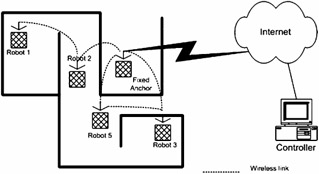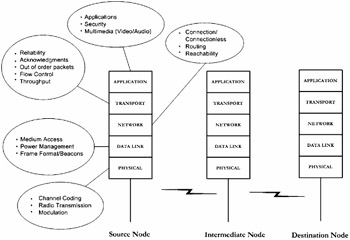16.2 A Wireless Ad Hoc Network Application
16.2 A Wireless Ad Hoc Network Application
Consider a team of robots, with communication and computation capabilities, that have been placed in an unexplored facility thought to contain a contaminator. The goal of the robot team is to map the entire terrain and to locate the contaminator. All robots can move around the facility freely, avoiding obstacles in their way; the exception is a single fixed anchor robot that communicates with the external world. Messages are sent between the controller and the anchor robot and such communication is established using the wireless WAN (see Figure 16.2). [10] The robots form a network dynamically and communicate with each other using the wireless channels without the aid of a fixed infrastructure. Two robots can exchange messages directly if they are in communication range of each other. The robot team must complete its task quickly. Due to limited battery life, the robots must be very prudent in power usage. We assume that an intelligent coordination protocol exists that avoids inspecting previously inspected areas. The robots exchange command-and-control messages apart from data messages that contain the information captured about the terrain. The control messages are sent from the controller to the anchor robot. These messages eventually are delivered from the anchor robot to all the mobile robots. The robots send video images to the anchor robot upon receiving commands from it. All messages are sent reliably, except the video images. This scenario application is very typical of the MANET environment. The issues that the protocols must address as a result in this scenario are:
-
Network partition is caused due to the host mobility and the associated packet losses.
-
Mobility may cause changes in the communication path. This may cause out-of-order delivery of packets.
-
The transmission range of the hosts is limited and this results in the need for extensive cooperation among nodes in the MANET for proper delivery of messages.
-
The broadcast nature of the wireless medium allows itself to be vulnerable to snooping and other security risks. It is subject also to frequent packet distortions due to collisions.
-
Batteries carried by the mobile hosts have a limited life.

Figure 16.2: Mobile robots application.
Figure 16.3 illustrates how the various layers of the OSI protocol stack must operate in order to successfully complete a communication session. Each of these layers is explained in detail in the sections that follow. For the sake of simplicity, the session layer and the presentation layer are assumed to be merged with the application layer.

Figure 16.3: Issues to be addressed by each layer of the protocol stack.
[10]One might imagine the anchor robot at the entrance of a tunnel, while the other robots are inside the tunnel. The anchor robot has the ability to communicate with the WAN.
EAN: 2147483647
Pages: 239